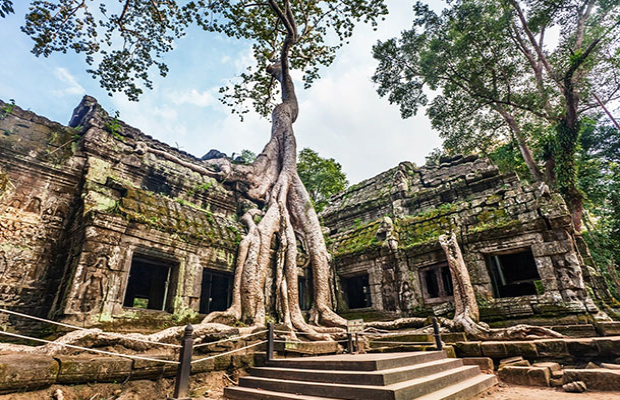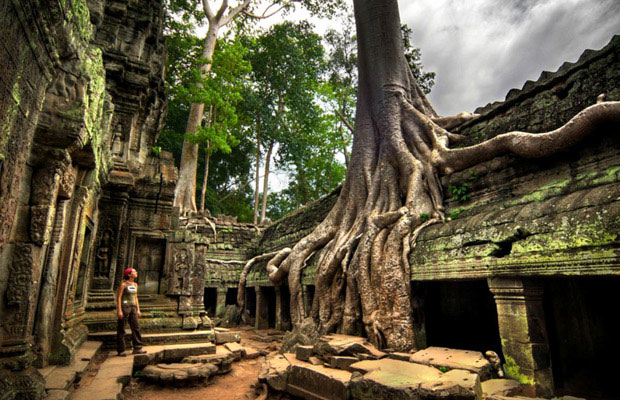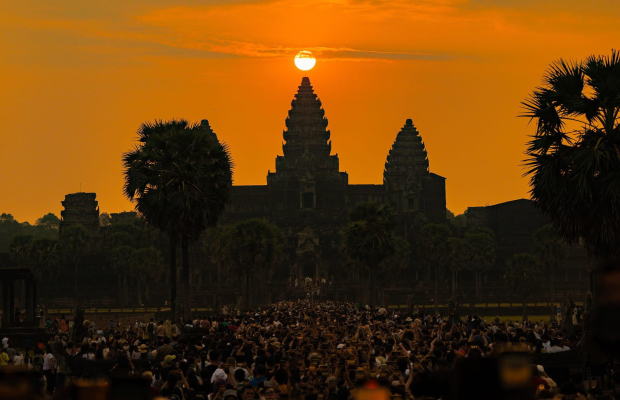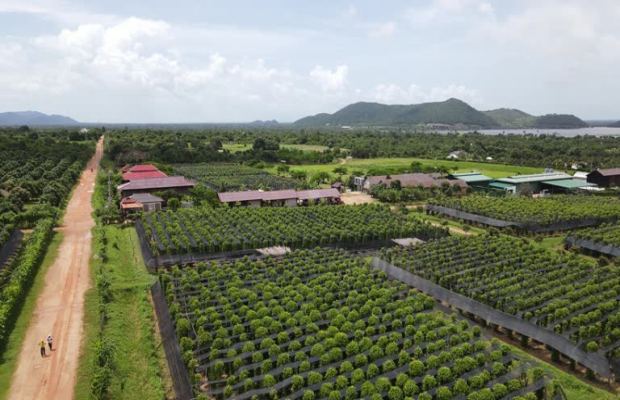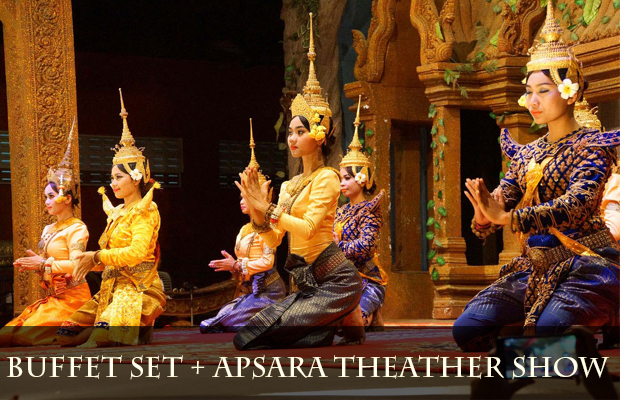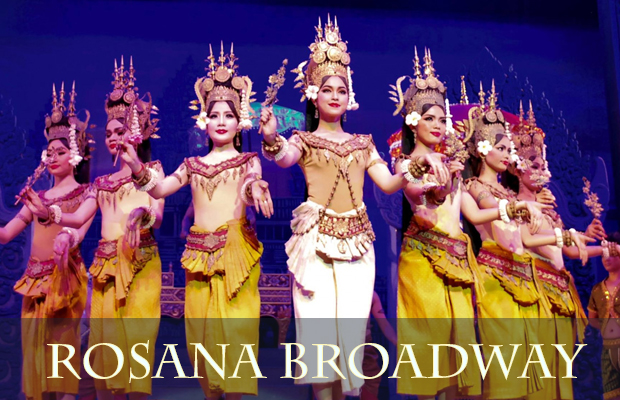Cambodia Temple Guide
Ta Prohm Temple
Ta Prohm's state of ruin is a state of beauty, which is investigated with delight and left with regret.
Ta Prohm is locating southwest of the East Mebon and east of Angkor Thom. Its outer enclosure is near the corner of Banteay Kdei. It can be accessed by enter the monument from the west and leave from the east entrance.
Tip: Ta Prohm is especially serene and beautiful in the early morning. A torch and a compass are useful for visiting this temple at all times. It was built about mid-12th century to early 13th century (1186) by the King Jayavarman VII, dedicated to the mother of the king (Buddhist) replica to Bayon style of art.
History of Prasat Ta Prohm
Ta Prohm is the undisputed capital of the kingdom of the Trees'. It has been left untouched by archaeologists except for the clearing of a path for visitors and structural strengthening to stave of further deterioration.
Because of its natural state, it is possible to experience at this temple the wonder of the early explorers when they came upon these monuments in the middle of the nineteenth century.
Shrouded in dense jungle the temple of Ta Prohm is ethereal in aspect and conjures up a romantic aura. Fig, banyan and kapok trees spread their gigantic roots over stones, probing walls and terraces apart, as their branches and leaves intertwine to form a roof over the structures. Trunks of trees twist amongst stone pillars. The strange, haunted charm of the place entwines itself about you as you go, as inescapably as the roots have wound themselves about the walls and towers', wrote a visitor 40 years ago.
A Sanskrit inscription on stone, still in place, give details of the temple. Ta Prohm 3,140 villages. It took 79,365 people to maintain the temple including 18 great priests, 2,740 officials, 2,202 assistants and 615 dancers. Among the property belonging to the temple was a set of golden dishes weighing more than 500 kilograms, 35 diamonds, 40,620 pearls, 4,540 precious stones, 876 veils from China, 512 silk beds and 523 parasols. Even considering that these numbers were probably exaggerated to glorify the king, Ta Prohm must have been an important and impressive monument.
Layout of Ta Prohm Temple
Ta Prohm is among the largest of the monuments in the Angkor complex, the in scrimption gives an idea of the size of the temple. The complex included 260 statues of gods, 39 towers with pinnacles and 566 groups of residences. Ta Prohm comprises a series of long low buildings standing on one level, which are enclosed by rectangular laterite wall (600 by 1,000 meters, 1,959 by 3,281 feet). Only traces of the wall are still visible. The center of the monument is reached by a series of towers connected with passages. This arrangement forms a ' sort of sacred way into the heart of the monument’; three-square galleries enclose the area.
Tip: Some areas of the temple are impassable and others are accessible only by narrow dark passages. It is recommended to follow the plan with a route and landmarks indicted or to stay with a guide to avoid getting lost.
The boundaries of the exterior wall are recognizable on the west by a stone entry tower in the shape of a cross, with an upper portion in the form of four faces, one looking towards each of the cardinal points (not shown on the plan). The approach to the west entrance of the temple is a path through the forest. After about 350 meters (1,148 feet) there is a stone terrace in the shape of a cross. Remains of lions, serpent balustrades and mythical creatures lie scattered in the area. Walk across the terrace to the vestibule of the enclosing wall. The view from this point is spectacular.
Every here around you, you see nature n this dual role of destroyer and consoler; strangling on the one hand, and healing on the other; no sooner splitting the carved stones asunder than she dresses their wounds with cool, velvety mosses, and binds them with her most delicate tendrils; a conflict of moods so contradictory and feminine as to prove once more if proof were needed how well " Dame "Nature merits her feminine title.
The next causeway with serpent balustrades on each side leads to an entry tower in the first enclosure around the temple. Inside, on the right, niches along the inner wall contain images of the Buddha.
Return to the center of the vestibule, turn right and walk through the courtyard to the annex building at the right. Continue walking straight through the series of rooms and passages to a tower. The relief on the horizontal beam is a fine representation of a scene from 'The Great Departure ' when the future. Buddha decides to leave his father's palace to live the life of a monk, the gods hold the hoofs of his horse so those sleeping in the palace are not awakened. Return to the courtyard and pass through an opening as opening in the wall of the second enclosure (at the south end).
The roots of a tree grip the double row of pillars in this gallery. Walk to the center of the complex, turn right and enter the entry tower of the third enclosing gallery. The inner walls are decorated with friezes of pendants, scrolls and figures in niches. Turn right again and walk into the central courtyard of the temple.
Representational art
Ta Prohm has not many narrative bas-reliefs(compared to Angkor Wat or Angkor Thom). One explanation that has been proffered for this dearth is that much of the temple's original Buddhist narrative artwork must have been destroyed by Hindu iconoclasts following the death of Jayavarman VII. At any rate, some depictions of scenes from Buddhist mythology do remain. One badly eroded bas-relief illustrates the "Great Departure" of Siddhartha, the future Buddha, from his father's palace. The temple also features stone reliefs of devatas (minor female deities), meditating monks or ascetics, and dvarapalas or temple guardians.
Trees
The trees growing out of the ruins are perhaps the most distinctive feature of Ta Prohm, and "have prompted more writers to descriptive excess than any other feature of Angkor."Two species predominate, but sources disagree on their identification: the larger is either the silk-cotton tree (Ceiba pentandra) or thitpok Tetrameles nudiflora, and the smaller is either the strangler fig (Ficus gibbosa). or Gold Apple (Diospyros decandra). Indulging in what might be regarded as "descriptive excess," Angkor scholar Maurice Glaize observed, "On every side, in fantastic over-scale, the trunks of the silk-cotton trees soar skywards under a shadowy green canopy, their long spreading skirts trailing the ground and their endless roots coiling more like reptiles than plants."
In popular media
The temple of Ta Prohm was used as a location in the film Tomb Raider. Although the film took visual liberties with other Angkorian temples, its scenes of Ta Prohm were quite faithful to the temple's actual appearance, and made use of its eerie qualities.
Some believe that one of the carvings resembles a stegosaurus.

